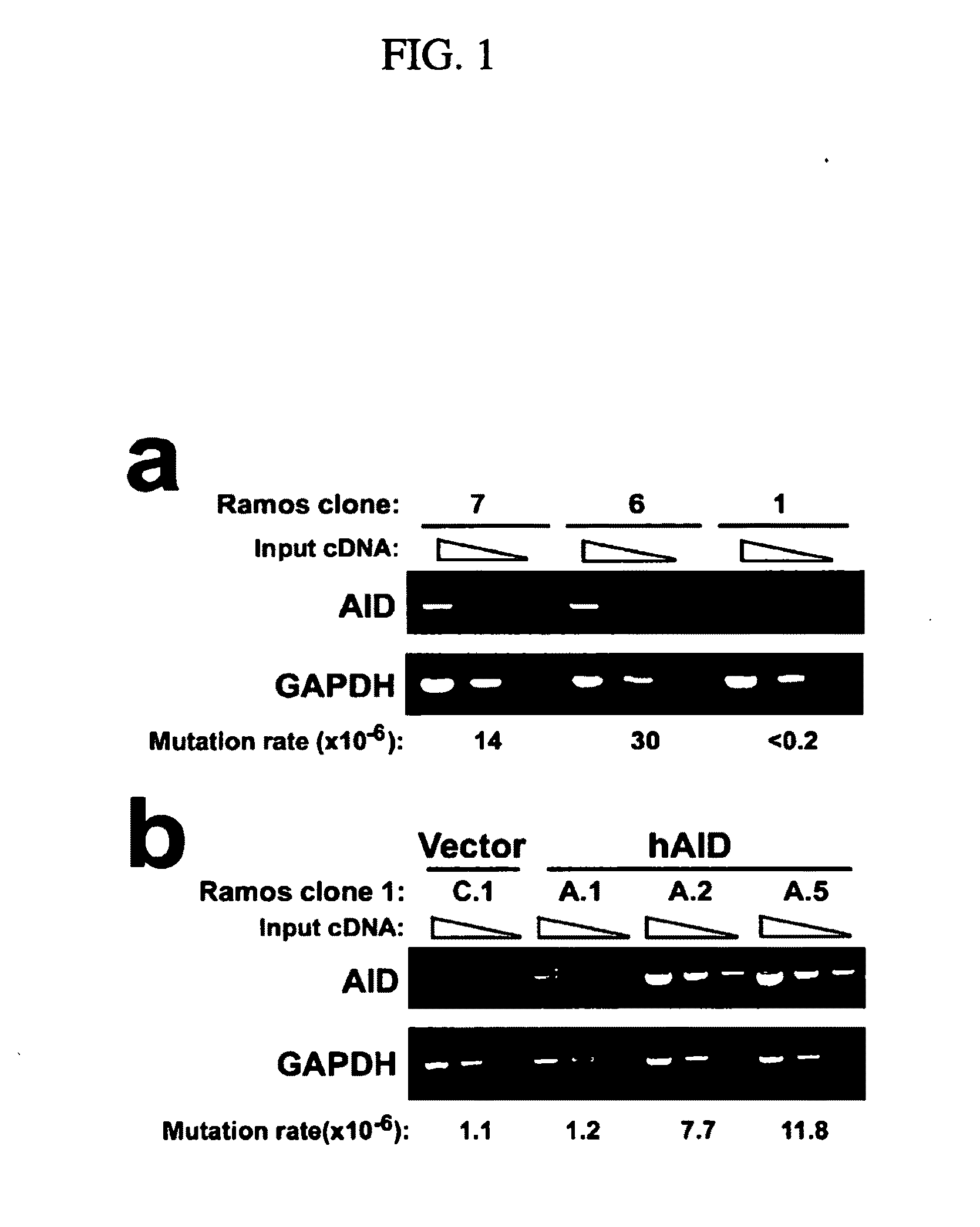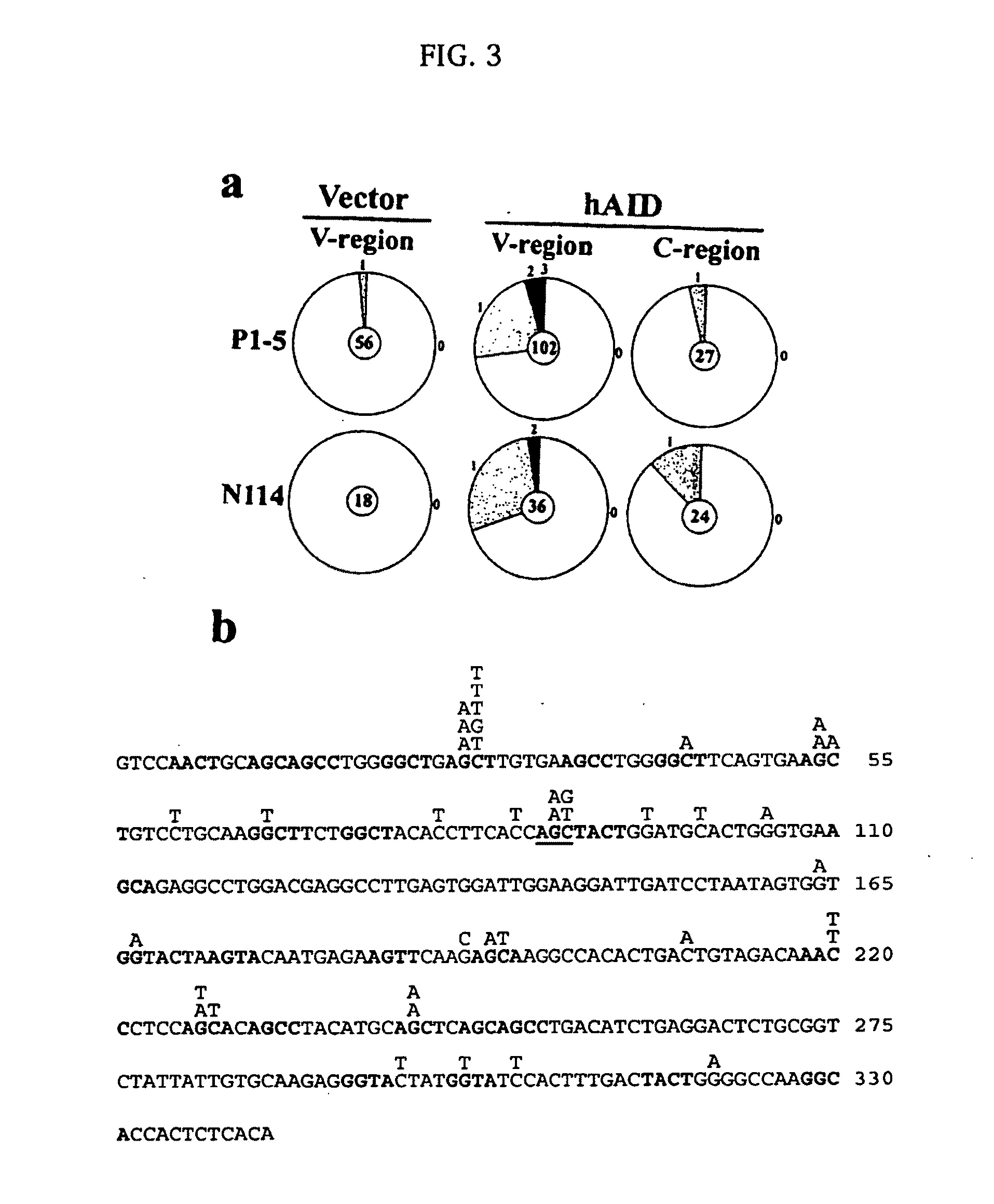Mutations caused by activation-induced cytidine deaminase
a technology of activation-induced cytidine and cytidine deaminase, which is applied in the field of activation-induced cytidine deaminase mutations, which can solve the problems of low affinity of monoclonal antibodies produced, no published studies that establish, and overexpressing b in cultured cells
- Summary
- Abstract
- Description
- Claims
- Application Information
AI Technical Summary
Problems solved by technology
Method used
Image
Examples
example 1
Expression of Aid and Somatic Hypermutation of Antibody Genes
[0172]In this Example, we establish that AID is required for somatic hypermutation (SHM) in centroblast-like Ramos cells. We then show that expression of AID is sufficient to induce SHM in hybridoma cells, which represent a later stage of B-cell differentiation that does not normally undergo SHM. Methods.
[0173]Cell lines, cell culture and transfection conditions: Ramos cells were grown as previously described (Zhang et al., 2001). N89 and N114 hybridoma cells were described previously (Connor et al., 1994), while the hybridoma P1-5 was obtained from Dr. Alfred Bothwell (Tao and Bothwell, 1990). Ramos cells were electroporated with 10 μg linearized DNA in IMDM medium at 250 volts, 960 μF, plated into 96 well plates, and selected with 0.6 mg / ml hygromycin B. The hybridoma cells were electroporated as described previously (Lin et al., 1997), and selected in 0.3 mg / ml hygromycin B. The ELISA spot assay was performed as previou...
example 2
AID-Activated Somatic Hypermutation in Non-B-Cells
[0186]To test whether AID can activate SHM in non-B-cells, Bw5147 (a T-cell line) and CHO (a hamster ovary cell line) were used. These cells were first transfected with immunoglobulin heavy and light chain genes by standard methods. Because the heavy chain gene (Igγ2a) has a nonsense codon in the V-region, the ELISA-spot assay can be used to determine whether AID can turn on SHM in these cells by assessing whether clones have reverted the nonsense codon and secrete IgG2a. Bw5147 and CHO clones that were stably-transfected with the immunoglobulin constructs were then transfected with empty vector or the vector expressing hA / D. Individual drug resistant colonies were grown up and assayed by the ELISA-spot assay. FIG. 4 shows that Bw5147 and CHO clones that express hAID have statistically higher reversion frequencies than clones that do not express hAID. These data indicate that hAID can activate SHM in non-B-cells. In addition, because...
example 3
Induction of Class-Switching by AID
[0187]In previous work, forced expression of AID in cultured B-cells (i.e. murine hybridomas and the human Burkitt's lymphoma cell line Ramos) turned on SHM with similar characteristics to that seen in vivo. This suggested that expression of AID was sufficient to initiate this process in B-cells that were at the wrong stage of differentiation. Since AID has also been implicated in class-switch recombination (Kinoshita and Honjo, 2001), we tested whether the Ramos clones that overexpress AID can be induced to class-switch to downstream isotypes. It is worth noting that previous attempts to induce class switch recombination in Ramos has either failed, or been only marginally successful. Since SHM is clonally unstable in Ramos cells (Zhang et al, 2001), and stability is due to the level of AID expression, we reason that Ramos failed to class-switch in those previous experiments because clonally stable Ramos cells were being used that express low level...
PUM
| Property | Measurement | Unit |
|---|---|---|
| half life | aaaaa | aaaaa |
| half life | aaaaa | aaaaa |
| nucleic acid | aaaaa | aaaaa |
Abstract
Description
Claims
Application Information
 Login to View More
Login to View More - R&D
- Intellectual Property
- Life Sciences
- Materials
- Tech Scout
- Unparalleled Data Quality
- Higher Quality Content
- 60% Fewer Hallucinations
Browse by: Latest US Patents, China's latest patents, Technical Efficacy Thesaurus, Application Domain, Technology Topic, Popular Technical Reports.
© 2025 PatSnap. All rights reserved.Legal|Privacy policy|Modern Slavery Act Transparency Statement|Sitemap|About US| Contact US: help@patsnap.com



